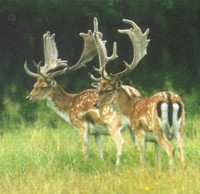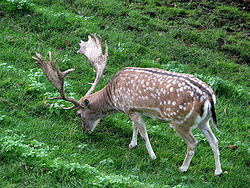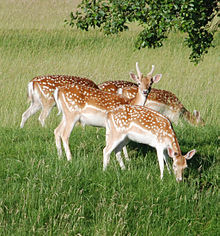The fallow deer is a ruminant mammal belonging to the family Cervidae. This common species is native to
western Eurasia, but has been introduced to Antigua and Barbuda, Argentina, South Africa, Fernando Pó, São
Tomé, Madagascar, Mauritius, Mayotte, Réunion, Seychelles, Comoro Islands, Morocco, Algeria, Tunisia, Cyprus,
Israel, Cape Verde, Australia, New Zealand, Canada, the United States, the Falkland Islands and Peru.
Some taxonomers include the rarer Persian fallow deer as a subspecies (D. d. mesopotamica), while others
treat it as an entirely different species (D. mesopotamica).
Characteristics
The male fallow deer is known as a buck, the female is a doe, and the young a fawn. Adult bucks are 140-160
cm (55-63 in) long with a 85-95 cm (33-37 in) shoulder height, and typically 60-100 kg (130-220 lb) in
weight; does are 130-150 cm (51-59 in) long with a 75-85 cm (30-33 in) shoulder height, and 30-50 kg (66-110
lb) in weight. The largest bucks may measure 190 cm (75 in) long and weigh 150 kg (330 lb). Fawns are
born in spring at about 30 cm (12 in) and weigh around 4.5 kg (9.9 lb). The life span is around 12-16 years.
There is much variation in the coat colour of the species, with four main variants: "common", "menil",
melanistic and leucistic a genuine colour variety, not albinistic. The white is the lightest coloured,
almost white; common and menil are darker, and melanistic is very dark, sometimes even black (easily confused
with the sika deer).
Common: Chestnut coat with white mottles that are most pronounced in summer with a much darker, unspotted
coat in the winter. Light-coloured area around the tail, edged with black. Tail is light with a black stripe.
Menil: Spots more distinct than common in summer and no black around the rump patch or on the tail. In
winter, spots still clear on a darker brown coat.
Melanistic (black): All year black shading to greyish brown. No light-coloured tail patch or spots.
Leucistic (white, but not albino): Fawns cream-coloured, adults become pure white, especially in winter.
Dark eyes and nose, no spots.
Most herds consist of the common coat variation, yet it is not rare to see animals of the menil coat
variation. The Melanistic variation is generally rarer and white very much rarer still, although wild New
Zealand herds often have a high melanistic percentage.
Only bucks have antlers, which are broad and shovel-shaped (palmate) from three years. In the first two years
the antler is a single spike. They are grazing animals; their preferred habitat is mixed woodland and open
grassland. During the rut bucks will spread out and females move between them, at this time of year fallow
deer are relatively ungrouped compared to the rest of the year when they try to stay together in groups of up
to 150.
Agile and fast in case of danger, fallow deer can run up to a maximum speed of 30 mph (48 km/h) over short
distances (being naturally less muscular than other cervids such as roe deer, they are not as fast). Fallow
deer can also make jumps up to 1.75 metres (approx 5.8 ft.) high and up to 5 metres (almost 17 ft.) in
length.
Behavior
Adult males are usually solitary. However, at the end of the summer months they may form small bachelor herds
of fewer than 6 and begin joining the female groups by early autumn, the beginning of the rut. In the
terminal phase of the rut males form smaller bachelor groups while females, fawns, and yearlings remain in
larger groups of 7 to 14. The smallest female herds are found during the fawning season.
Fallow deer are active mainly nocturnally and exhibit peak activity periods during dusk and dawn. They lead a
shy and withdrawn existence in the forests. In general, deer are more alert in open areas or in smaller
groups; females are usually more alert than males, especially when their fawn are present. Depending on
reproductive status and diet quality, fallow deer spend most of their time feeding, resting, and moving.
Dama dama lift their legs higher than any other species when they trot. They jump with all four feet in the
air and carry their tails erect when fleeing. (Feldhamer et al. 1998; Grizmek 1990; Nowak 1999).
Distribution
The fallow deer is a Eurasian deer that was a native to most of Europe during the last Interglacial. In the
Holocene, the distribution was restricted to the Middle East and possibly also parts of the Mediterranean
region, while further southeast in western Asia was the home of the Persian fallow deer, that is bigger and
has larger antlers. In the Levant, fallow deer were an important source of meat in the Palaeolithic
Kebaran-culture (17000-10000 BCE), as is shown by animal bones from sites in northern Israel, but the numbers
decreased in the following epi-Palaeolithic Natufian culture (10000-8500 BCE), perhaps because of increased
aridity and the decrease of wooded areas.
Diet
Fallow deer are herbivores and graze all types of ground vegetation. They also browse shrub layers in a wood,
and the growing shoots and leaves of holly and beech trees. Fallow deer inhabit woodland both for food and
shelter, but they like to feed in arable fields on root crops such as carrots, sugar beet, parsnips or
potatoes.
Habitat
Fallow deer live in isolated groups in the forest. They range over large areas and spend only a short time
in one area. But they can cause a great deal of damage by feeding on buds and leaves, and they will also
strip bark from trees.
Reproduction
During the breeding period, or rut, males spend most of their time establishing their territory (rut stand)
by pawing the ground to create scrapes where they may urinate, thrashing understory vegetation with their
antlers, and by producing low-pitched groans and grunts. At the onset of the rut, since deer are polygynous,
the females also appear at the rut stand. Males may stop feeding at this time. Many subordinate males unable
to establish territories remain around the edges of the herd, but they are chased away by the rutting male if
they enter the territory.
Mating occurs during the rut. Males fight often and violently during the mating season but injuries are rare;
their fights involve a ritual shoving with the antlers that follow fixed rules. When mating, the male
approaches the female many times, sniffing and licking her genital areas in order to determine if she is in
estrous. The female responds with a high-pitched whine and moves away. Eventually the female allows the male
to mount.







